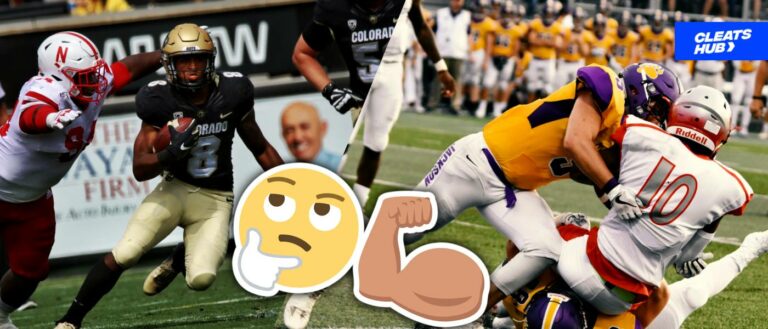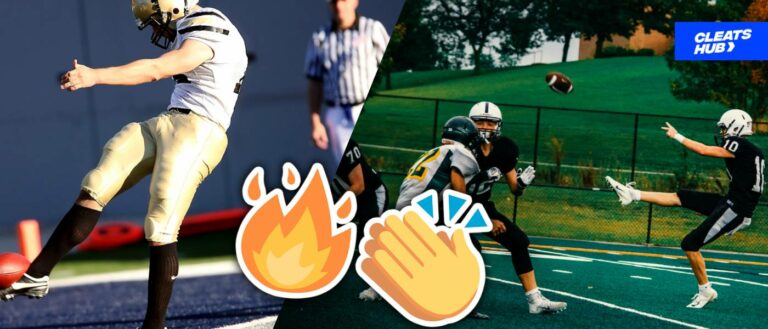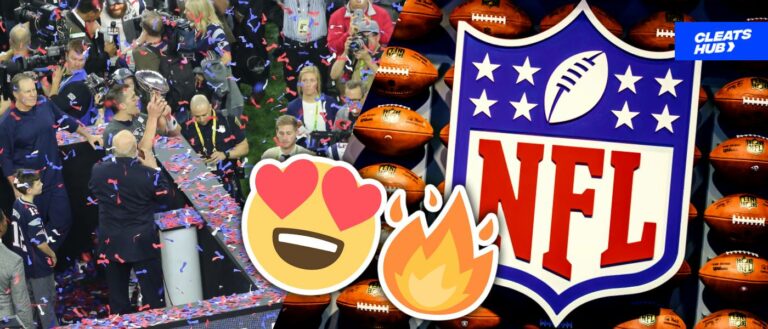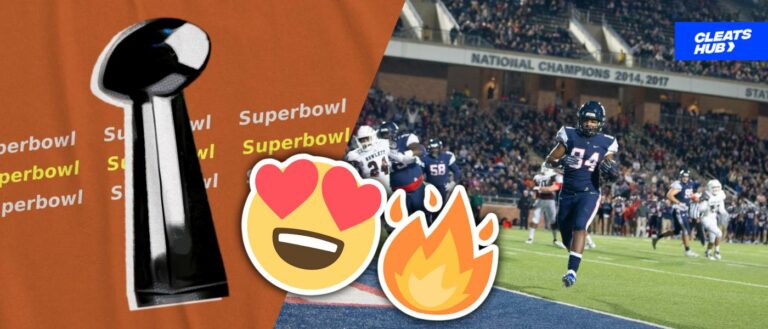Who Are Wide Receivers In Football? (WR Position)
In the exciting world of American football, wide receivers emerge as the seductive stars of the passing game. As they negotiate the gridiron, these aerial acrobats draw attention by extending their limbs to retrieve whirling footballs from the air.
We dig into the enigmatic world of wide receivers in this interesting piece, showing their strategic worth, dynamic abilities, and much more.
About Wide Receivers In Football
Wide receivers in football are the players who go wide inside the opposing team’s defensive zone and position themselves to catch a pass from the quarterback. In every offensive game, they work hand-in-hand with the quarterback.
When a wide receiver has positioned himself in the opposing team’s defensive zone, he waits for the quarterback to find him and send a pass. As he waits, he is tailed by the cornerback who is waiting to tackle him.
Immediately after the quarterback throws the ball, the wide receiver moves fast and swiftly in a bid to shake off the cornerback. After this, when he is free, he catches the ball and goes for a touchdown.
Role of the Wide Receivers
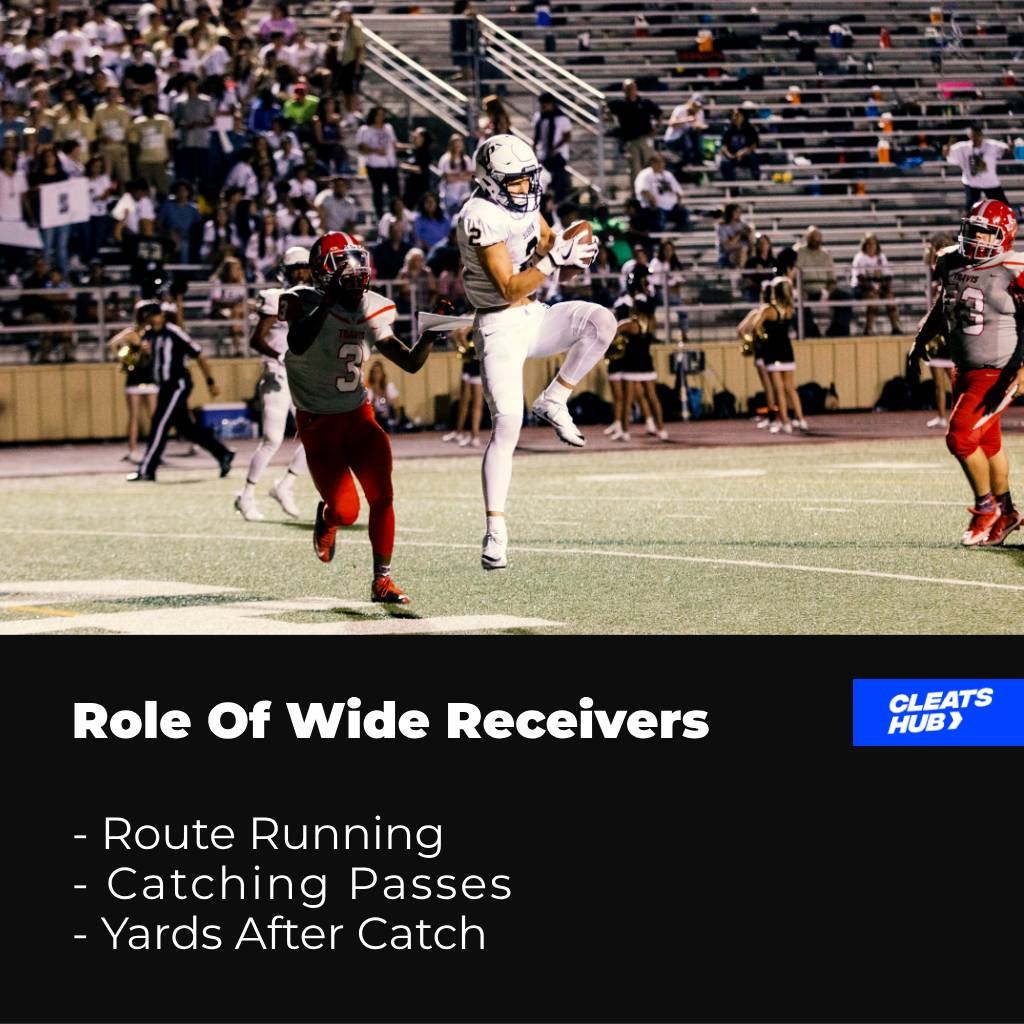
1. Route Running
Wide receivers need to be extremely fast, agile, and accurate with their route running. They must use a variety of routes, including slants, curls, posts, digs, and go routes, to get past defenders.
Moreover, by mastering these routes, receivers may get ahead of defenses and provide the quarterback with good throwing choices.
2. Catching Passes
A wide receiver’s ability to catch the football is one of their core competencies. In order to keep the ball in their possession, they must have strong hands, superb hand-eye coordination, and focus.
Additionally, wide receivers use a variety of catching methods, such as utilizing their hands, bodies, or a mix of both.
3. Yards After Catch (YAC)
Wide receivers try to gain as many yards as possible after making a catch by using their quickness, elusiveness, and speed.
Also, YAC, or the capacity to gain extra yards after receiving the ball, is essential for advancing the chains and extending drives.
4. Blocking
Wide receivers are crucial in both pass protection and running plays when it comes to blocking. Secondly, to open up lanes for their teammates to run in, they must be good at blocking and impeding opponents.
In addition, a receiver’s flexibility and commitment to the success of the team are demonstrated through their blocking abilities.
Key Wide Receiver Positions
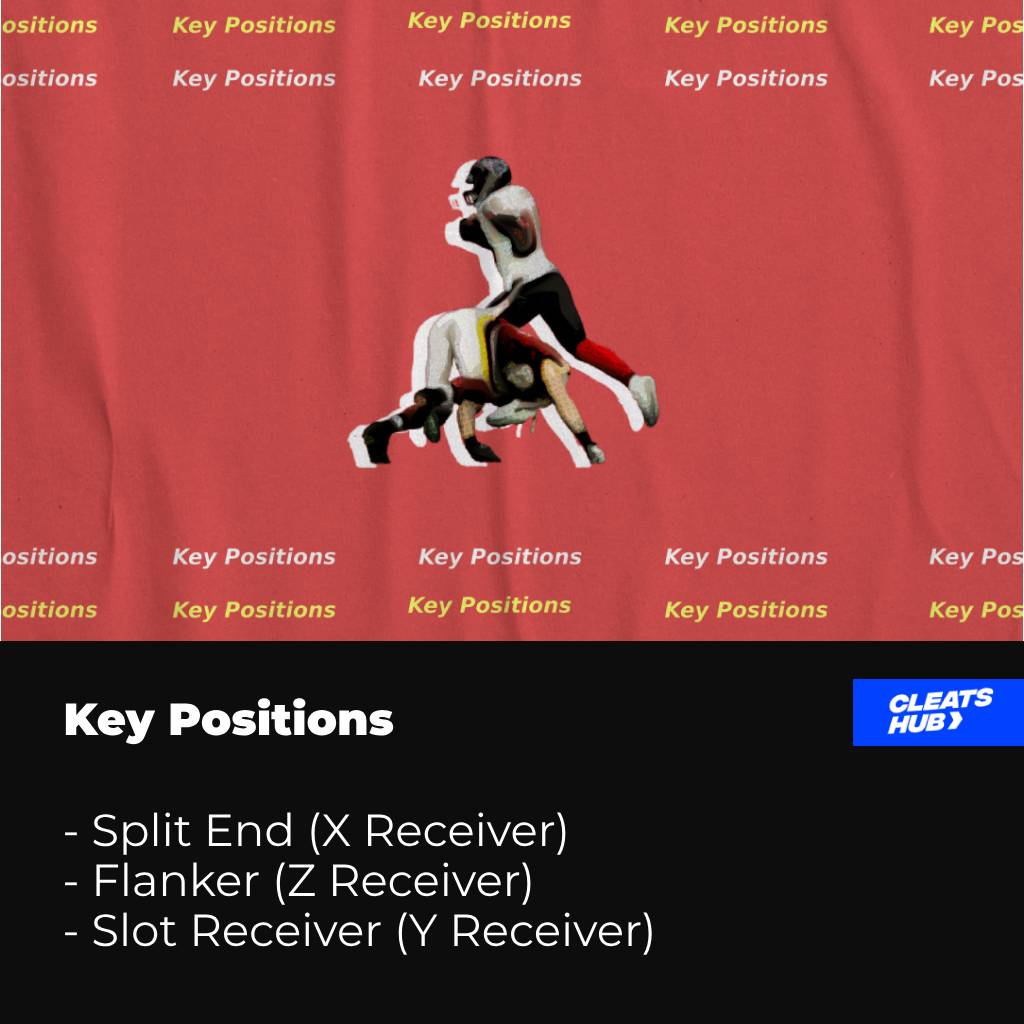
There are a number of important roles and places that wide receivers may play in the offense when it comes to football. Depending on the offensive strategy a team uses, these positions may change.
Following are a few typical wide receiver positions:
1. Split End (X Receiver)
On the line of scrimmage, the split end normally lines up on the side opposite the tight end. They are frequently the main deep threat.
Therefore, it is expected of them to excel at running long routes while stretching the defense with their speed and athleticism.
2. Flanker (Z Receiver)
The flanker usually lines up on the same side as the tight end or in between the split end and the offensive line when he lines up off the line of scrimmage.
Before the snap, they often have a little more room to move, which enables them to be used in a variety of patterns and actions.
3. Slot Receiver (Y Receiver)
A step below the line of scrimmage, the slot receiver (or Y receiver) sets up between the split end and the offensive line. They operate in the “slot” and are frequently utilized as intermediate or below-route runners.
Moreover, the majority of the time, slot receivers are quick and nimble, and able to separate in the center of the field.
Also, they may serve as viable targets for short and intermediate throws.
Qualities of Elite Wide Receivers

- Speed and Quickness:
Wide receivers frequently have great speed, which enables them to outpace defenders and establish separation. They must be able to shift directions quickly to avoid covering and locating open areas on the field. - Route Running Precision:
Elite receivers have a good comprehension of route principles, which enables them to run clean, accurate routes. They are skilled at using double movements, generating deception, and analyzing the defense to find holes in covering strategies. - Hands and Ball Skills:
Wide receivers with strong ball control and dependable hands are a team’s most valued assets. They frequently make challenging catches and have superb body control and hand-eye coordination. During crucial circumstances, their capacity to make contested receptions in traffic or near the sidelines frequently proves essential. - Football Intelligence:
The top wide receivers have a keen comprehension of football, according to football intelligence. They are skilled at analyzing defenses, identifying coverages, and modifying their routes appropriately.
Rules Wide Receivers Have To follow

In American football, wide receivers must abide by several regulations that control their behavior on the field. The following are some guidelines for wide receivers to abide by:
1. Line of Scrimmage
Wide receivers must line up on or behind the line of scrimmage before the snap. When a player crosses the line of scrimmage before the ball is snapped, he is penalized for unlawful formation.
2. Pass Interference
Wide receivers attempting to grab a pass must not interfere with defensive players. They are not permitted to push, pull, or block a defender’s movement. Offensive pass interference penalties may be given if a receiver significantly affects a defender’s ability to make a play on the ball.
3. Illegal Contact
Wide receivers are not permitted to make first contact with a defender more than five yards from the line of scrimmage. Also, if a receiver makes contact with a defender downfield, a penalty for unlawful contact or defensive holding may be given.
4. Alignment and Motion
When it comes to position and movement before the snap, wide receivers must follow specific criteria. They must line up according to predefined rules, such as being on or off the line of scrimmage.
Wide receivers can also move before the snap, but they must pause for a limited period of time to avoid a false start penalty.
5. Fair Catch
When catching a punt, wide receivers have the option to request a fair catch. By declaring a fair catch, the receiver can escape being tackled by defenders and is forbidden from attempting to move the ball.
It is vital to note that the goal of this rule is to protect the receiver during punt returns.
6. Illegal Touching
A wide receiver cannot be the first player to touch a forward throw if they purposefully step out of bounds during a play. They also receive an illegal touching penalty if they are the first to touch the ball after going out of bounds.
7. Blocking Rules
According to blocking rules, wide receivers are authorized to block as part of their offensive duties. There are, however, principles for blocking methods and actions.
Also, they must refrain from making illegal blocks, such as blocking below the waist, blocking in the back, or making contact with a defender’s head or neck. It’s important to note that the rules of American football can be complicated and open to interpretation by referees.
Furthermore, the aforementioned criteria provide a broad overview of some key standards that wide receivers must follow, but there may be other intricacies and particular conditions that influence how they conduct themselves on the field.
Top Wide Receivers in NFL History
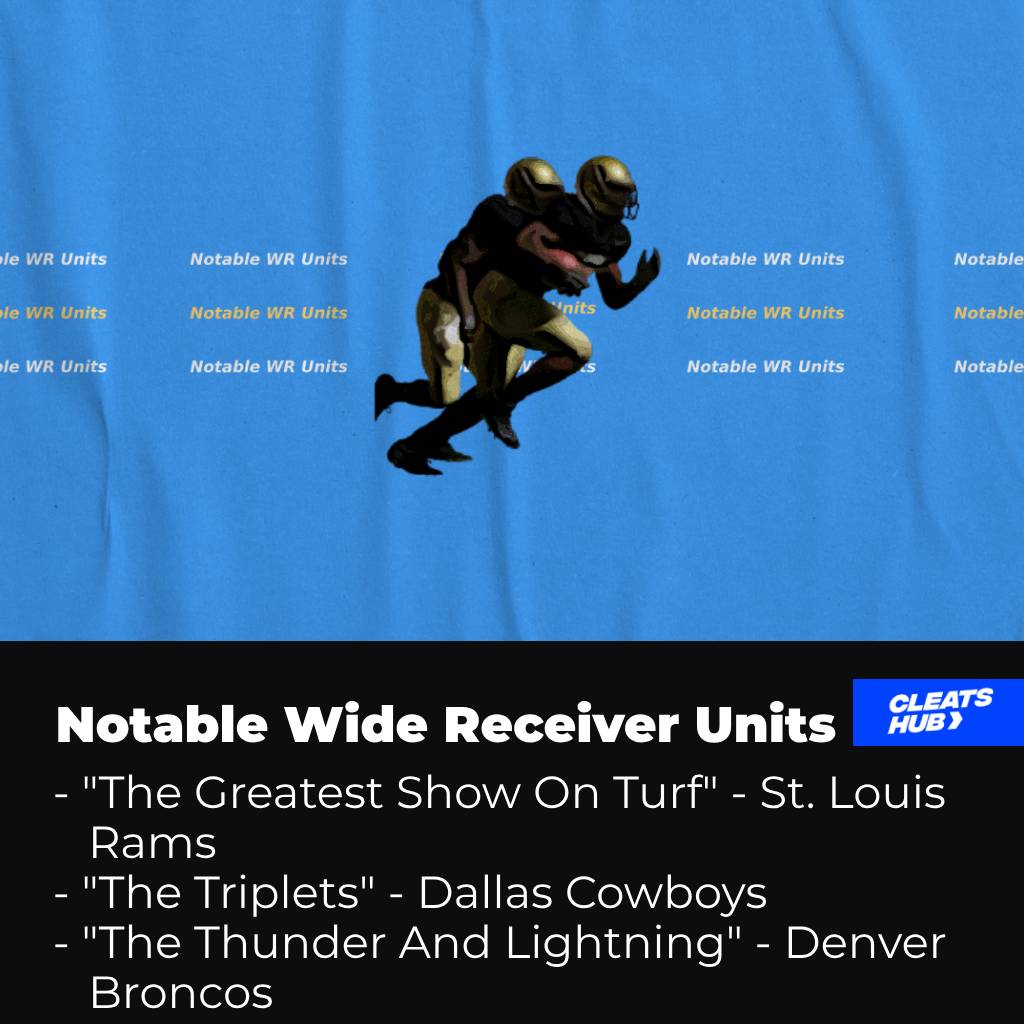
There have been many great wide receiver units in the history of the NFL. However, we have narrowed down five of the great units below:
1. The Greatest Show on Turf – St. Louis Rams’ Wide Receivers Group of 1999-2001
The Rams’ wide receiver duo of Isaac Bruce and Torry Holt revolutionized the passing game in the late 1990s and early 2000s. Also, Bruce, and Holt frightened defenses with their speed, route running, and exceptional hands, while Kurt Warner threw accurate passes.
Furthermore, this trio was critical to the Rams’ dynamic offensive, which led to their Super Bowl XXXIV victory.
2. The Triplets – Dallas Cowboys’ Wide Receiver group of the 1990s
Michael Irvin, Alvin Harper, and Jay Novacek, the renowned wide receiver trio who ruled the 1990s, must be mentioned in any discussion of great wide receiver groups.
Furthermore, Hall of Famer Irvin captained the team and epitomized adaptability and dependability. Harper’s deep-threat speed and Novacek’s ability as a pass-catching tight end complemented Irvin’s toughness and penchant for making key catches.
Furthermore, the services of this exceptional receiving group were critical to the Cowboys’ Super Bowl victories in the early 1990s.
3. The Thunder and Lightning – The Denver Broncos’ Wide Receivers Group of 1996-1998
When discussing top wide receiver pairings, the Broncos’ Rod Smith and Ed McCaffrey combination must be mentioned. Because of Smith’s exceptional route running and McCaffrey’s height and bulk, they were a challenge to defenses.
Furthermore, with quarterback John Elway, they developed an explosive passing offense that helped the Broncos win back-to-back Super Bowls in 1997 and 1998.
4. The Fun Bunch – Washington Redskins’ Wide Receivers Group of the 1980s
The Redskins receiving corps, led by Art Monk and Gary Clark in the 1980s, was a fearsome foe. Clark’s deep threat speed, combined with Monk’s dependability and ability to move the chains, proved lethal.
This trio was heavily relied on by quarterback Joe Theismann and was critical to the Redskins’ Super Bowl victory in 1987.
5. The Greatest Show on Grass – Arizona Cardinals’ Wide Receivers Group of 2008-2009
Larry Fitzgerald and Anquan Boldin were a strong wide-receiving tandem for the Cardinals when they won the Super Bowl in 2008.
Fitzgerald’s excellent hands and ability for acrobatic receptions, combined with Boldin’s size and aggression, provided ongoing challenges for opposing teams. Furthermore, quarterback Kurt Warner’s precision and efforts enabled the Cardinals’ passing offense to reach new heights.
Top 10 Wide Receivers In The NFL (2023)
There are many talented wide receivers in football. In this section, we will be ranking the top 10 receivers in 2023.
| Ranking | Players | Teams |
| 1 | Davante Adams | Las Vagas Raiders |
| 2 | Justin Jefferson | Minnesota Vikings |
| 3 | Tyreek Hills | Miami Dolphins |
| 4 | Cincinnati Bengals | Cincininati Bengals |
| 5 | Stefon Diggs | Buffalo Bills |
| 6 | Copper Kupp | Los Angeles Rams |
| 7 | A.J Browns | Philadelphia Eagles |
| 8 | Terry McLaurin | Washington Commanders |
| 9 | Ceedee Lamb | Dallas Cowboys |
| 10 | Deebo Samuel | San Francisco 49ers |
Conclusion
Wide receivers epitomize American football’s captivating blend of tact, agility, and creativity. They reach their full potential by running precise routes, making receptions that defy gravity, and making explosive yards after catches.
Moreover, these playmakers in the air excite spectators with their unmatched speed, agility, and football knowledge. Every mind-blowing catch or jaw-dropping block is a reminder of the influence wide receivers have on the field.


